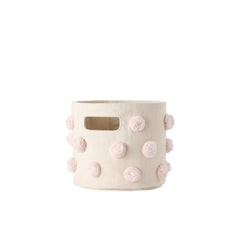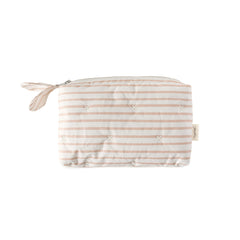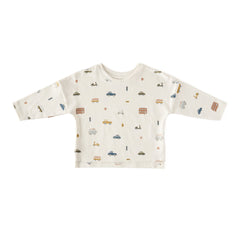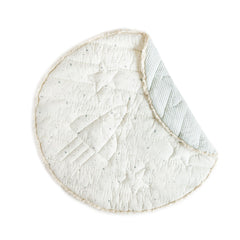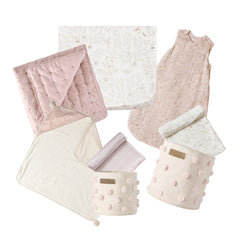The first years of your baby’s life are full of exciting events. From first steps to first words, to first smiles, there is truly never a dull moment. One of the most important developmental milestones to watch out for in the first few months of your little one’s life is when your baby rolls over. This may seem like a simple action to us but for a newborn baby, it’s a big deal! Rolling over takes a lot of practice and strength and it’s worth celebrating. So, why is rolling over such an important developmental milestone? When do babies roll over? Why is it important to be prepared for your little one’s first spin? And, how can you help your infant roll over? We’re answering all of your questions in today’s article.
Table of Contents
- Why rolling over is an important milestone
- When do babies roll over?
- Why it’s important to be prepared for when your baby starts to roll over
- How to help your infant roll over
Why rolling over is an important milestone
To adults, rolling over might seem like an incredibly simple movement but, to a newborn, rolling over is a huge developmental milestone. Rolling over will likely be your little one’s first experience with independent mobility. This motion will also help your newborn begin to develop the muscles that they will need in order to reach their next big milestones like sitting up on their own, crawling, and, eventually, walking.
Rolling also helps newborns develop two important senses involved in sensory-motor integration:
- Vestibular - the movement, gravity and/or balance sense that allows us to move smoothly and maintain our balance
- Proprioceptive - also known as kinesthesia is your body's ability to sense movement, action, and location
Finally, rolling over also gives your little one an opportunity to exercise their curiosity and begin to explore the world around them on their own.

When do babies roll over?
Many new parents wonder: when do babies roll over? And, like so many things in parenting, there is not a single, definitive answer to this question. Each newborn will have their own individual timeline for development. However, knowing (on average) when you can expect your little one to start exploring their mobility can help you better prepare for this important milestone.
Most babies can roll over by around 6 months of age but many babies can and do roll over long before that. Babies can start to try and roll over from their stomachs to their backs as early as 2 months of age. So, it’s a good idea to keep a close eye out for this behavior starting at around the 2-month mark.
While some babies will successfully roll over from their stomach to back shortly after they start exploring the movement, others may need a few months of practice. Rolling over from back to stomach typically happens later in newborn development. By around 6 months of age, most babies will successfully be able to roll from their backs onto their tummies.

Why it’s important to be prepared for when your baby starts to roll over
Now that we’ve answered the question: when do babies roll over? Let’s discuss why it’s so important to be prepared for when your baby masters this new movement. Once your little one can successfully roll over, you’ll need to start taking a few extra precautions. Firstly, you’ll need to ensure that your baby is never left unattended on a high surface like a changing table. In fact, it’s a good idea to make sure that you always have one hand on your little one if they are on an elevated surface especially if they have the ability to roll over in one or both directions.
Once your baby has mastered the roll over, you may also observe that they prefer to sleep on their stomach or side. It’s a good idea to continue to put your child to sleep on their back but, typically, if your baby can autonomously roll over, it is likely safe for them to sleep on their side or stomach. If you’re unsure or concerned about your little one’s sleep safety, be sure to consult with your pediatrician.

How to help your infant roll over
The best way to teach your child how to roll over is by ensuring that they have daily, dedicated tummy time. As the name suggests, tummy time is when your baby is placed on their stomach while they are awake and supervised. It isn’t just about preventing conditions like positional plagiocephaly and positional torticollis. It’s also helpful for promoting healthy growth and development in your baby. Tummy time gives your little one the opportunity to develop their neck, back, and shoulder muscles. Tummy time will help your baby meet key developmental milestones like pushing up on their arms, lifting their head, rolling over, and, eventually, crawling.
As long as your baby remains supervised the entire time, tummy time is perfectly safe for newborns. Infants can have 2 - 3 sessions that last about 3 - 5 minutes each and every day. Having a few essentials on hand for tummy time can make the process a lot smoother! Here are a few items we recommend:
- A comfortable blanket or play mat. Our play mats are quilted to give your baby a little bit of extra cushioning. Interesting patterns and textures can also keep your little one engaged and entertained.
- If you’re doing a tummy time session on soft surface, a swaddle blanket is a great option to lay down over your bed or couch.
- It’s also a good idea to have some toys on hand. You can use these to distract and soothe your little one, as well as encourage them to engage different muscles as they reach for their favorite play items.
- Regular pillows are great to have on hand as well. You can line these up around your tummy time area to keep your baby safe and contained.
- Finally, have some storage baskets nearby because tummy time will come and go several times a day. Having a nearby storage pint or basket will help you keep your living area organized while also ensuring all of your essentials are handy for your next session.
We hope you now feel confident and equipped to help your baby reach this exciting developmental milestone and well-informed on what to keep in mind once your baby becomes more mobile and independent!

